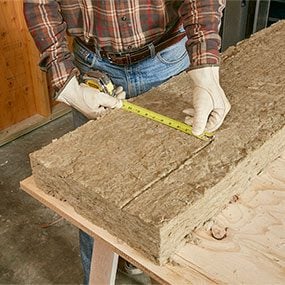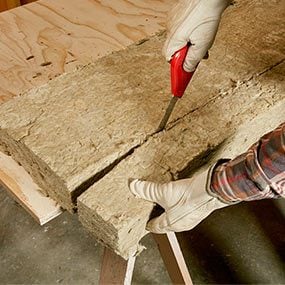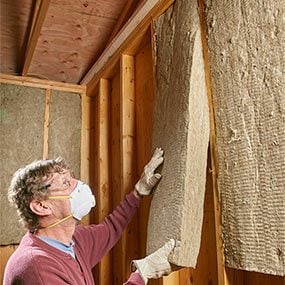Mineral Wool Insulation R-Value
Mineral stone wool insulation batts are slightly better insulators than the off-the-shelf fiberglass batts sold at most lumberyards and home centers. Mineral wool batts for 2×4 walls have an R-value of 15, while a standard fiberglass batt made to fit in a 2×4 wall has an R-value of 11 or 13. However, you can special-order R-15 high-density fiberglass batts. (The larger the R-value, the better insulator the material is.)
Mineral wool batts for 2×6 walls have an R-value of 23, compared with R-19 for fiberglass batts. A 2×4 stud cavity filled with blown-in cellulose has an R-value of about 13. Spray foam insulates better than all of these, but it’s far more expensive.
Cost and Availability of Mineral Wool Insulation
On a square-foot basis, mineral wool batts cost more than fiberglass batts. As an example, the R-15 mineral wool costs about 80¢ per sq. ft. vs. 60¢ for fiberglass. There are at least three brands of mineral wool batts for thermal wall insulation: Johns Manville TempControl, Roxul ComfortBatt and Thermafiber UltraBatt. Be aware, though, that you may have to special-order mineral wool batts. We used Roxul r value insulation batts.
Fire Resistance
Mineral wool withstands extreme heat better than other types of insulation. In a fire, the batts retain their shape and offer better protection against flame spread. And you builders may be interested to learn that when they’re combined with special fire-rated sheathing, mineral wool batts can be used to create a one-hour-fire-rated assembly without any extra labor.
Water Resistance
Another cool property of mineral wool batts is that they don’t absorb water, staying intact even when wet. This means that if your wall or roof leaks, the batts will be as good as new after they dry out. Fiberglass or cellulose, on the other hand, droop, clump up or compress when they get wet. And sometimes, the only way to restore their insulating value is to tear off the wall covering and replace them. When it comes to water resistance, only foam insulation beats mineral wool.
The Itch Factor
Like fiberglass, mineral wool contact can make you itch or even cause a mild rash. Some installers say it’s a little worse than fiberglass; some say a little better. I can’t tell the difference. Regardless of which material you install, be sure to wear a dust mask, goggles, gloves and a long sleeve shirt.
Sound Blocking

Batts stay put, even on ceilings
If you’ve ever installed fiberglass batts on ceilings, you know that they’ll fall out if you don’t add support. Not so with mineral wool batts. Just push them into place and walk away.
Mineral wool batts are denser than other types of stone wool insulation, making them better at soundproofing interior walls, floors and ceilings. Install batts between rooms or in the joist spaces between floors to reduce sound transmission.
Installation

You can mark mineral stone wool insulation batts
The batts are so dense that you can mark them by dragging the hook of your tape measure across the surface. There’s no need to position and cut along a straightedge the way you might with fiberglass.

Cuts like bread
With a serrated knife or the special serrated saw, it’s simple to cut accurately along a line. This means you can fit the insulation tightly into even oddly shaped spaces for added thermal efficiency. You can even slice slivers to accurately fill narrow spaces.

Mineral wool batts are rigid
Unlike fiberglass batts, mineral wool batts hold their shape. That makes them easier to handle and easier to install. They don’t flop over or need fluffing up like fiberglass.

You can carve mineral wool
Mineral wool batts are so dense that you can carve them to accurately fit around outlets and other obstacles. Just measure and mark like you would if you were making a drywall cutout. This works for outlets, pipes or any other obstruction you’re likely to run into.
It’s much easier to do a top-notch insulation job if you use mineral wool instead of fiberglass. Because of its greater rigidity, mineral wool can be cut more exactly, allowing precise trimming around outlets and other obstructions. By contrast, fiberglass batts simply aren’t easy to install accurately. They’re floppy, hard to cut precisely, and prone to overstuffing.
Did you miss our previous article...
https://rsssuperfeeds.com/life-hacks/the-10-best-paint-roller-techniques-and-tips-for-perfect-walls






